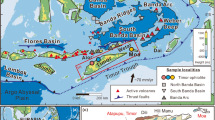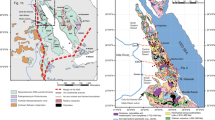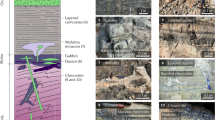Abstract
Rock types similar to those found in ophiolites have been recovered from the floors of ocean basins1–3. This is critical evidence for the theory that ophiolites represent the ocean crust4,5. Aumento6 has described diorites, quartz diorites and trondhjemites dredged from the Mid-Atlantic Ridge (MAR) near 45° N, and noted that these were the first rocks analogous to the low-K acid differentiates in ophiolites (collectively referred to as ‘oceanic plagiogranites’7,8) to be recognized amongst those recovered from the modern ocean floor. Only a few plagiogranites from the ocean floor (ocean-crust plagiogranites) have since been described; these were dredged from widely spaced localities on the MAR9–11, the Amani Plateau and the Kyushu-Palau Ridge (north-west Pacific)12. However, the Kyushu-Palau Ridge could be the product of destructive plate-margin magmatism13, as are the potassic granites from the Aves Ridge (Caribbean)14. Plagiogranite xenoliths also occur in extrusives on Surtsey and Askja (Iceland)15. That only some of the petrological compositions of ophiolite plagiogranites are represented in the ocean crust is not surprising in view of the small sample of ocean-crust plagiogranites. It is less obvious, however, if ophiolites represent the ocean crust, why certain acidic rock types from the oceans have not been found in ophiolites. I show here that the difference between the two groups of plagiogranites is evidence that ophiolites do not represent all kinds of ocean crust and that a greater range of magma compositions and/or conditions of magmatic differentiation is represented by the ocean crust.
This is a preview of subscription content, access via your institution
Access options
Subscribe to this journal
Receive 51 print issues and online access
$199.00 per year
only $3.90 per issue
Buy this article
- Purchase on Springer Link
- Instant access to full article PDF
Prices may be subject to local taxes which are calculated during checkout
Similar content being viewed by others
References
Aumento, F., Loncarevic, B. D. & Ross, D. I. Phil. Trans. R. Soc. A268, 623–650 (1971).
Cann, J. R. Phil. Trans. R. Soc. A268, 605–617 (1971).
Thompson, G. Chem. Geol. 12, 99–111 (1973).
Gass, I. G. Nature 220, 39–42 (1968).
Dewey, J. F. & Bird, J. M. J. geophys. Res. 76, 3179–3206 (1971).
Aumento, F. Science 165, 1112–1113 (1969).
Coleman, R. G. & Peterman, Z. E. J. geophys. Res. 80, 1099–1108 (1975).
Coleman, R. G. & Donato, M. M. in Trondhjemites. Dacites and Related Rocks (ed. Barker, F. ) (Elsevier, New York, 1979).
Bonatti, E., Honnorez, J. & Ferrara, G. Earth planet. Sci. Lett. 9, 247–256 (1970).
Christensen, N. I. Earth planet. Sci. Lett. 36, 297–300 (1977).
Miyashiro, A. Earth planet. Sci. Lett. 7, 361–365 (1970).
Ishizaka, K. & Yanagi, T. Earth planet. Sci. Lett. 27, 371–377 (1975).
Uyeda, S. Bull. geol. Soc. Am. 85, 1159–1170 (1974).
Walker, B. M., Vogel, T. A. & Ehrlich, R. Earth planet. Sci. Lett. 15, 133–139 (1972).
Sigurdsson, H. Geol. mag. 105, 440–453 (1968); Nature 269, 25–28 (1977).
Coleman, R. G. Ophiolites (Springer, Berlin, 1977).
Aldiss, D. T. thesis, Open Univ. (1978).
Alleman, F. & Peters, T. Eclog. geol. Helv. 65, 657–697 (1972).
Bloxham, T. W. Trans. R. Soc. Edinb. 68, 105–122 (1968).
Engel, C. G. & Fisher, R. L. Bull. geol. Soc. Am. 86, 1553–1578 (1975).
Hedge, C. E., Futa, K., Engel, C. G. & Fisher, R. L. Contr. Miner. Petrol. 68, 373–376 (1979).
Abbotts, I. L. Geol. Mag. 115, 415–425 (1978).
Kay, R. W. & Senechal, R. G. J. geophys. Res. 81, 964–970 (1976).
Spooner, E. T. C. & Fyfe, W. S. Contr. Miner. Petrol. 42, 287–304 (1973).
Gass, I. G. Geol. Soc. Lond. Spec. Publ. 7, 72–76 (1977).
Pearce, J. A. Tectonophysics 25, 41–67 (1975).
Wood, D. A., Gibson, I. L. & Thompson, R. N. Contr. Miner. Petrol. 55, 241–254 (1976).
Frey, F. A., Bryan, W. B. & Thompson, G. J. geophys. Res. 79, 5507–5527 (1974).
Nakamura, N. Geochim. cosmochim. Acta 38, 757–775 (1974).
Author information
Authors and Affiliations
Rights and permissions
About this article
Cite this article
Aldiss, D. Plagiogranites from the ocean crust and ophiolites. Nature 289, 577–578 (1981). https://doi.org/10.1038/289577a0
Received:
Accepted:
Issue Date:
DOI: https://doi.org/10.1038/289577a0
This article is cited by
-
The largest plagiogranite on Earth formed by re-melting of juvenile proto-continental crust
Communications Earth & Environment (2021)
-
Geochronology and geochemistry of an early Silurian plagiogranite from Xiarihamu area, East Kunlun, northwest China: implications for Proto-Tethyan evolution
Arabian Journal of Geosciences (2021)
-
Trace element geochemistry of zircons from the Kahnouj ophiolite complex: implications for petrogenesis and geodynamic setting
Arabian Journal of Geosciences (2021)
-
Early Cambrian Muli arc–ophiolite complex: a relic of the Proto-Tethys oceanic lithosphere in the Qilian Orogen, NW China
International Journal of Earth Sciences (2019)
-
The Juchatengo complex: an upper-level ophiolite assemblage of late Paleozoic age in Oaxaca, southern Mexico
International Journal of Earth Sciences (2018)
Comments
By submitting a comment you agree to abide by our Terms and Community Guidelines. If you find something abusive or that does not comply with our terms or guidelines please flag it as inappropriate.



